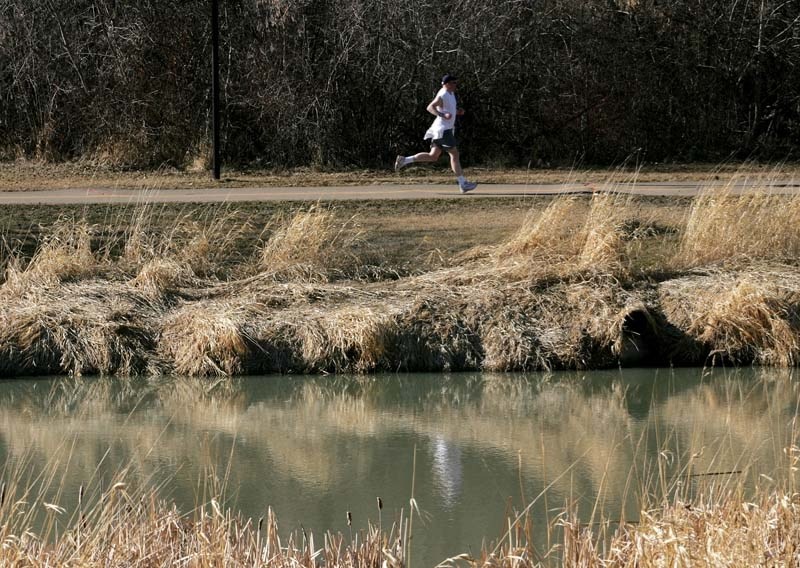People new to endurance running will inevitably receive advice from others about the sport – whether it's how to run, where to run, what kind of shoes to buy or how many times per day you should be eating. Sifting through the anecdotes and opinions can be trying, which is why we went to the experts to debunk popular running myths.
Running is hard on your knees
Endurance running has long been given a bad rap for wreaking havoc on your joints, specifically leading to the onset of osteoarthritis.
This is a belief that John Stanton, founder and president of the Running Room, hopes to dispel among the general population and especially new runners.
"Staying active through running or walking will keep the mobility in your joints and help strengthen the muscles and tendons around your joints," he said. "Like everything, it has to be done intelligently and with some moderation."
Past studies have noted early-detection signs of knee arthritis in long distance runners as well as athletes who compete in sports where lots of running is involved. However, the relationship between the physical impact of running and cartilage degeneration is still unclear as both very high and very low levels of physical activity can contribute to its degeneration.
Among respondents in a study published earlier this year, runners had approximately half the risk of developing osteoarthritis and needing hip replacements as the walkers. Researches explained this was in part due to the low body mass index (BMI) of runners. Low BMI decreases osteoarthritis risk.
"If you follow a proper program, running is a terrific exercise," said Stanton. "I think one of the biggest mistakes people make is they go too fast, too far, too soon and that's when they get injured."
For those who are serious about endurance running, experts recommend consulting with a running coach to reduce your risk of injury – repetitive injury is another risk factor for osteoarthritis.
Stanton advises new runners to start off with walk-runs as part of a "rest and stress" routine. By alternating high intensity with low intensity physical activity, athletes will reap cardiovascular benefits without taking on too much.
Striving for perfection
Consulting with a coach or joining a running group will help new athletes better understand their bodies and the best way for their bodies to move.
"One of the fallacies is that there's a perfect way to run," he stated. "If you want to see perfect running form, go down to the playground and watch children at play. They're all relaxed and having fun and they're running according to their body type."
Stanton stressed there is no perfect form; relaxation is the key to better performance.
"Relax, power and glide. The more relaxed we are and rhythmic in our running form, the better we will be."
The truth about carb-loading
Consuming too many carbohydrates is a mistake many amateur athletes make, explained Tania Vander Meulen, registered dietitian with Kensington Physical Therapy in St. Albert.
Although carbohydrates are the main source of the body's fuel, people who regularly run under 90 minutes don't need to be loading up on pastas and breads, she said. Otherwise they end up 'kicking themselves in the butt' for overcompensating on the calories for the amount of training they're doing.
"Once your glycogen stores are at where they should be, you can't supersaturate them," said Vander Meulen, adding glycogen stores – the way your body stores carbohydrates – will replenish as physical activity goes up. Recreational runners do not need to increase their carbohydrate intake like marathon runners who are more likely to 'hit the wall' before the finish line.
Vander Meulen, who has been running for the past 15 years, said everyone, not just distance runners, also tend to overestimate how much protein they need. Although protein is required to compensate for tissue damage and recovery, it only adds up to an extra serving – or three palm-sized servings per day.
"The most crucial thing is what you're eating about 15 to 30 min after your long runs," she said, recommending a good mix of carbohydrate and protein. Post run snacks may include: two cups of white or chocolate milk, 1.5 cups of fruit smoothie, a sandwich of meat and cheese or peanut butter and jam with a piece of fruit, or a slice of pizza.
The need to hydrate
Drinking too much or too little water can both have detrimental effects on your performance. For the recreational endurance runner, the Dietitians of Canada recommend drinking four to five cups of fluid – water is your best choice – before your run, so you're producing clear urine.
Runners can adjust their water intake – before, during and after running – depending on how much they sweat. It is recommended to drink just enough water to make up for the water you lose through sweat.
Vander Meulen explained athletes can weigh themselves before and after physical activity to check the amount of water they need to replenish, every pound lost requires 500 millitres of fluid.
"It's not ideal that you lose any weight during your runs, that's a good indicator that you're not drinking enough," she said.
This is the second of a three-part series on endurance running.




